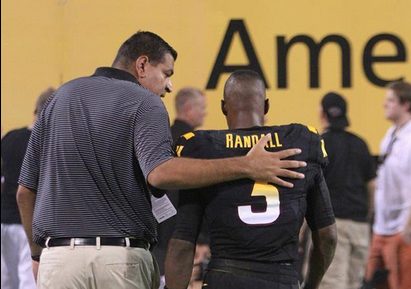
(Photo: Scotty Bara/WCSN)
Two weeks ago, the No. 14 Arizona State football team had a special teams unit that was producing at the same rate as the Western Michigan Broncos. Cronkite Sports writer Adam Stites reported it, I am reminding you of it.
Fortunately for the Sun Devils, the punt returning unit has managed to scrape together a few somewhat respectable performances, and have catapulted three spots to 124th (out of 128 schools) in the country in the last two games. The timing was perfect for the Sun Devils, as the improvement managed to avoid embarrassment on a national stage to a Stanford team that ranked 6th in the nation in punt returns.
But the improvement must continue for ASU, as Saturday’s matchup against No. 17 Utah poses a similar prospect of humiliation.
Utah’s punt coverage has been stellar this season: 10 punts, only 25 yards allowed, culminating in a measly 2.5 yards per return. Much of this credit has to go to punter Tom Hackett, whose 47 yards per punt rank fourth in the country.
Defensive coordinator and special teams coach Keith Patterson agrees.
“One, I think it starts with their kickers,” Patterson said. “The punter is a weapon, the way he rugby punts it, he places the ball all over the field. He’s got an extremely strong leg so it’s hard to get a beat on setting up returns and things like that.”
ASU safety and punt returner Damarious Randall will be affected most by Hackett’s tactics, which may not be the brightest of news for the Sun Devils. The punt return corps as a whole has been stagnant, averaging only 1.9 yards per return, but Randall is the main culprit—his six punt returns lead the team, yet he has only mustered a total of six yards on those opportunities. To further complicate the matter, the Sun Devils have not faced a punter in the same league of talent as Hackett.
Looking for positive takeaways, at least Randall realizes what he will be facing on Saturday.
“They have a pretty good punter,” Randall said. “He can place the ball wherever he wants and whenever he wants. Most of the time he just kicks it away from the returner. They flip the field with their returns. Utah’s special teams are great.”
Randall’s last sentence in the above statement underscores why Utah’s special teams are clearly great: Not only is Hackett one of the nation’s top punters, but Kaelin Clay, Utah’s punt and kickoff returner, is equally as dangerous.
With a nation-leading three punt return touchdowns, one kickoff return touchdown and 22.5 yards per punt return (third in the country), the senior Clay truly does flip the field on opposing teams and adds to the well-roundedness of Utah’s special teams attack.
Just like Randall has the responsibility of neutralizing Hackett, the responsibility of accounting for the prolific Clay rests on the shoulders of Sun Devil punter Matt Haack.
It would be unjust to group Haack in the discussion surrounding ASU’s abysmal special teams play. The sophomore has raised his punting average from 38.3 yards in 2013 to 43.4 yards this year. Perhaps more impressively, he also bombed a new career-long, 64-yard punt in the swirling winds of Seattle last week.
Still, Clay’s talents will force Haack to deliver another solid performance.
“The big thing is hang time and consistency,” Haack said. “You kick the ball high enough, your coverage will get down there so there’s no chance to return it. Kind of kick it away from him, making him run for the ball, putting him in tough positions to catch it, those are the big things.”
The focus on hang time was the same for Stanford, as Adam Stites documented here. But this time, Haack delved into the fundamentals of how increased hang time is actually accomplished.
“A lot of it is about the drop,” Haack said. “You raise your drop a little bit, keep it flat, and make sure the nose isn’t pointed down. When the nose is pointed down it tends to drive a little more. Really just focusing on the drop and keeping my leg straight.”
Is analyzing the subtleties of kicking a football higher for a few seconds splitting hairs in the grand scheme of the outcome of the game? Possibly. But recall that it was a special teams play, a 54-yard blast punt from Haack that was fumbled by Ty Montgomery, which swayed the momentum in the Stanford game. Also, it is precisely this detailed concentration on special teams over the past two weeks that has substantially improved the unit’s performances.
“A lot more focus and emphasis and effort on it,” Haack said. “Everyone’s doing their job. Punt-wise, from the snap to the protection, to the coverage, the kick, everyone’s doing their job, fitting their pieces together. It just comes down to focus, really.”
“I see improvement, I see our kids gaining confidence,” Patterson added. “I mean, (kickoff man Alex) Garoutte’s last three kicks the other night were as good as you’ll see. Haack has been punting the football… The other night, kicking into that wind, the guy raises his average a yard, kicks his career-long kick, 64 yards. You can see him gaining confidence each and every week.”
Haack and even the rest of the Sun Devils special teams unit have reason to be confident. Though the process may be painfully incremental, agonizingly slow and difficult to watch, progress is clearly being made. Saturday night against a special teams’ juggernaut Utes team will simply be a test of how much still needs to be accomplished.
Follow Jacob Garcia on Twitter @Jake_M_Garcia or connect with him on LinkedIn.


